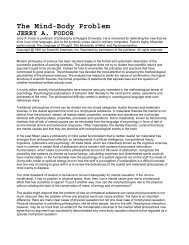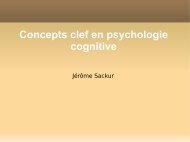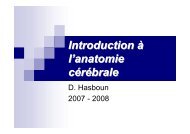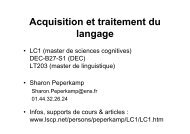408 B.F. Penning<strong>to</strong>n / Cognition 101 (2006) 385–413 degrades process B and vice versa. But the same is true in patients with acquired <strong>disorders</strong> (see discussion <strong>of</strong> cases <strong>of</strong> acquired dyslexias in Van Orden et al., 2001) and is typical <strong>of</strong> <strong>developmental</strong> <strong>disorders</strong>. Connectionist <strong>models</strong> <strong>of</strong> dissociations in both typical (e.g., Elman et al., 1996) and atypical development (e.g., Harm & Seidenberg, 1999), as well as in brain damage syndromes (e.g., Farah, 1994) make it clear that a dissociation at the level <strong>of</strong> behavior does not always require a separate stage or process at the cognitive level. So <strong>single</strong> and double dissociations are hardly an infallible <strong>to</strong>ol for dissecting the underlying cognitive architecture. However, the issue <strong>of</strong> modularity is partly separable from the issue <strong>of</strong> <strong>single</strong> vs. <strong>multiple</strong> deWcits. Even if there are innate modules, because the etiologies <strong>of</strong> <strong>developmental</strong> <strong>disorders</strong> act very early in brain development, they would likely aVect more than one module, which is the concept <strong>of</strong> pleiotropy. And even if the etiologies <strong>of</strong> diVerent <strong>developmental</strong> <strong>disorders</strong> were independent (which we have shown is not true for behaviorally deWned <strong>disorders</strong> like dyslexia and ADHD), as long as these etiologies acted pleiotropically there would likely be shared cognitive risk fac<strong>to</strong>rs across <strong>disorders</strong>. So two <strong>of</strong> the main ideas <strong>of</strong> the <strong>multiple</strong> cognitive deWcit model – <strong>multiple</strong> cognitive deWcits in any given disorder and partly shared cognitive risk fac<strong>to</strong>rs across <strong>disorders</strong> – could be derived from a strong innate modularity theory, given pleiotropy. But the <strong>multiple</strong> deWcit idea does contradict the idea <strong>of</strong> a complete 1:1 mapping between etiologic and cognitive risk fac<strong>to</strong>rs, which would lead <strong>to</strong> each disorder having its own <strong>single</strong> independent cognitive deWcit. In sum, this paper has traced how my thinking has evolved from <strong>single</strong> <strong>to</strong> <strong>multiple</strong> cognitive deWcit <strong>models</strong> <strong>of</strong> <strong>developmental</strong> <strong>disorders</strong>. Multiple cognitive deWcit <strong>models</strong> are more consistent with the multifac<strong>to</strong>rial and probabilistic etiology <strong>of</strong> such <strong>disorders</strong>. But challenges remain in how <strong>to</strong> specify and test <strong>multiple</strong> cognitive deWcit <strong>models</strong>. Acknowledgements This work was supported by NIH Grants MH38820, HD27802, HD04024, HD- 17449, and HD35468. Helpful comments on earlier drafts <strong>of</strong> this paper were kindly provided by Richard Boada, Claudia Cardoso-Martins, Christa HutaV, Lauren McGrath, Richard Olson, Sally OzonoV, Robin Peterson, Erin Phinney, and three anonymous reviewers. References Angold, A., Costello, E. J., & Erkanli, A. (1999). Comorbidity. Journal <strong>of</strong> Child Psychology and Psychiatry, 40(1), 57–87. Aram, D. M., Ekelman, B. L., & Nation, J. E. (1984). Preschoolers with language <strong>disorders</strong>: 10 years later. Journal <strong>of</strong> Speech and Hearing Research, 2(2), 232–244. August, G. J., & GarWnkel, B. D. (1990). Comorbidity <strong>of</strong> adhd and reading disability among clinic-referred children. Journal <strong>of</strong> Abnormal Child Psychology, 1(1), 29–45. Badian, N. A. (1997). Dyslexia and the double deWcit hypothesis. Annals <strong>of</strong> Dyslexia, 47, 69–87.
B.F. Penning<strong>to</strong>n / Cognition 101 (2006) 385–413 409 Bird, J., & Bishop, D. V. (1992). Perception and awareness <strong>of</strong> phonemes in phonologically impaired children. European Journal <strong>of</strong> Disorders in Communication, 2(4), 289–311. Bird, J., Bishop, D. V., & Freeman, N. H. (1995). Phonological awareness and literacy development in children with expressive phonological impairments. Journal <strong>of</strong> Speech and Hearing Research, 3(2), 446–462. Bishop, D. V. (1997). Cognitive neuropsychology and <strong>developmental</strong> <strong>disorders</strong>: uncomfortable bedfellows. Quarterly Journal <strong>of</strong> Experimental Psychology, 5(4), 899–923. Bishop, D. V., & Adams, C. (1990). A prospective study <strong>of</strong> the relationship between speciWc language impairment, phonological <strong>disorders</strong> and reading retardation. Journal <strong>of</strong> Child Psychology and Psychiatry, 3(7), 1027–1050. Bishop, D. V., North, T., & Donlan, C. (1995). Genetic basis <strong>of</strong> speciWc language impairment: evidence from a twin study. Developmental Medicine and Child Neurology, 3(1), 56–71. Bowers, P. G. (1993). Text reading and rereading: determinants <strong>of</strong> Xuency beyond word recognition. Journal <strong>of</strong> Reading Behavior, 25, 133–153. Caron, C., & Rutter, M. (1991). Comorbidity in child psychopathology: concepts, issues and research strategies. Journal <strong>of</strong> Child Psychology and Psychiatry, 3(7), 1063–1080. Castellanos, F. X., & Tannock, R. (2002). Neuroscience <strong>of</strong> attention-deWcit/hyperactivity disorder: the search for endophenotypes. Nature Reviews Neuroscience, 3, 617–628. Catts, H. W., Fey, M. E., Tomblin, J. B., & Zhang, X. (2002). A longitudinal investigation <strong>of</strong> reading outcomes in children with language impairments. Journal <strong>of</strong> Speech, Language, and Hearing Research, 4(6), 1142–1157. Clark, L. A., Watson, D., & Reynolds, S. (1995). Diagnosis and classiWcation <strong>of</strong> psychopathology: challenges <strong>to</strong> the current system and future directions. Annual Review <strong>of</strong> Psychology, 46, 121–153. Clarke-Klein, S., & Hodson, B. W. (1995). A phonologically based analysis <strong>of</strong> misspellings by third graders with disordered-phonology his<strong>to</strong>ries. Journal <strong>of</strong> Speech, and Hearing Research, 3(4), 839–849. Dickman, G. E. (2003). The nature <strong>of</strong> learning disabilities through the lens <strong>of</strong> reading research. Perspectives: The International Dyslexia Association, 29, 4–8. Doehring, D. G., Trites, R. L., Patel, P. G., & Fiedorowicz, C. A. M. (1981). Reading disabilities: The interaction <strong>of</strong> reading, language and neuropsychological deWcits. New York: Academic Press. Dykman, R. A., & Ackerman, P. T. (1991). Attention deWcit disorder and speciWc reading disability: separate but <strong>of</strong>ten overlapping <strong>disorders</strong>. Journal <strong>of</strong> Learning Disabilities, 2(2), 96–103. Edwards, J., & Lahey, M. (1998). Nonword repetitions in children with speciWc language impairment: exploration <strong>of</strong> some explanations for their inaccuracies. Applied Psycholinguistics, 19, 279–309. Elman, J. L., Bates, E. A., Johnson, M. H., KarmiloV-Smith, A., Parisi, D., & Plunkett, K. (1996). Rethinking innateness. Cambridge, MA: The MIT Press. Farah, J. J. (1994). Neuropsychological inference with an interactive brain. Behavioral and Brain Sciences, 17, 90–104. Fisher, S. E., & DeFries, J. C. (2002). Developmental dyslexia: genetic dissection <strong>of</strong> a complex cognitive trait. Nature Reviews Neuroscience, 3(10), 767–780. Friedman, M. C., Chhabildas, N., Budhiraja, N., Willcutt, E. G., & Penning<strong>to</strong>n, B. F. (2003). Etiology <strong>of</strong> the comorbidity between reading disorder and attention deWcit hyperactivity disorder: exploration <strong>of</strong> the non-random mating hypothesis. American Journal <strong>of</strong> Medical Genetics, 120B(1), 109–115. Frith, U. (1985). Beneath the surface <strong>of</strong> <strong>developmental</strong> dyslexia. In K. E. Patterson, J. C. Marshall, & M. Coltheart (Eds.), Surface dyslexia: Neuropsychological and cognitive studies <strong>of</strong> phonological reading (pp. 301–330). Hillsdale: Lawrence Erlbaum. Frith, U. (2003). Autism: Explaining the enigma. Oxford: Blackwell. Gallagher, A., Frith, U., & Snowling, M. J. (2000). Precursors <strong>of</strong> literacy delay among children at genetic risk <strong>of</strong> dyslexia. Journal <strong>of</strong> Child Psychology and Psychiatry, 4(2), 203–213. Gayan, J., Willcutt, E., Fisher, S. E., Francks, C., Cardon, L., Olson, R. K., et al. (2005). Bivariate linkage scan for reading disability and attention-deWcit/hyperactivity disorder localizes pleiotropic loci. Journal <strong>of</strong> Child Psychology and Psychiatry, 46(10), 1045–1056. Hall, P. K., & Tomblin, J. B. (1978). A follow-up study <strong>of</strong> children with articulation and language <strong>disorders</strong>. Journal <strong>of</strong> Speech and Hearing Disorders, 4(2), 227–241. Hallgren, B. (1950). SpeciWc dyslexia: A clinical and genetic study. Acta Psychiatrica Neurologica Scandinavia, 6, 1–287.







